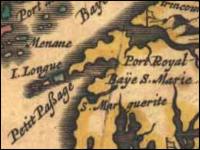


History - Port-Royal
(con't)
In 1635, agriculture, fishing, fur and lumber operations assured the survival of the Acadians. They also built dykes that served to dry the marshes and provide sea salt to preserve the fish they caught.
| In 1636, Isaac de Razilly died and Aulnay was his successor. Aulnay became Governor General and Lord of Acadia by royal proclamation. He became (with Razilly) the true organizer of the Acadian colony. From 1632 to 1650, approximately 50 French families established themselves in Acadia. In 1650 Aulnay died and LaTour became governor and king’s lieutenant in Acadia. | |
|
In 1654, a war erupted between France and England over territory boundaries, under orders from Major Sedgwick, of Boston. LaTour went to London where he was able to obtain from Cromwell, along with Sir Thomas Temple, a share of Acadia. During the English occupation of Port-Royal by Sedgwick, the French colonists were moved up the Port-Royal River (Annapolis River, also rivière Dauphin). Knowing that Acadia would eventually be returned to France, Colbert, minister of Louis XIV, forbid them from leaving the territory without permission. The treaty of Bréda, signed in 1667, transferred Acadia back to France. |
|
